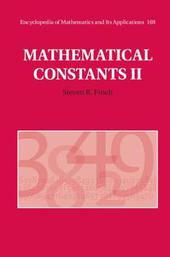
|
Mathematical Constants II
Hardback
Main Details
| Title |
Mathematical Constants II
|
| Authors and Contributors |
By (author) Steven R. Finch
|
| Series | Encyclopedia of Mathematics and its Applications |
|---|
| Physical Properties |
| Format:Hardback | | Pages:782 | | Dimensions(mm): Height 241,Width 160 |
|
| Category/Genre | Maths for scientists |
|---|
| ISBN/Barcode |
9781108470599
|
| Classifications | Dewey:513 |
|---|
| Audience | | Professional & Vocational | |
|---|
| Illustrations |
Worked examples or Exercises; 32 Tables, black and white; 32 Halftones, black and white; 47 Line drawings, black and white
|
|
Publishing Details |
| Publisher |
Cambridge University Press
|
| Imprint |
Cambridge University Press
|
| Publication Date |
6 December 2018 |
| Publication Country |
United Kingdom
|
Description
Famous mathematical constants include the ratio of circular circumference to diameter, = 3.14 ..., and the natural logarithm base, e = 2.718 .... Students and professionals can often name a few others, but there are many more buried in the literature and awaiting discovery. How do such constants arise, and why are they important? Here the author renews the search he began in his book Mathematical Constants, adding another 133 essays that broaden the landscape. Topics include the minimality of soap film surfaces, prime numbers, elliptic curves and modular forms, Poisson-Voronoi tessellations, random triangles, Brownian motion, uncertainty inequalities, Prandtl-Blasius flow (from fluid dynamics), Lyapunov exponents, knots and tangles, continued fractions, Galton-Watson trees, electrical capacitance (from potential theory), Zermelo's navigation problem, and the optimal control of a pendulum. Unsolved problems appear virtually everywhere as well. This volume continues an outstanding scholarly attempt to bring together all significant mathematical constants in one place.
Author Biography
Steven R. Finch is Research Computing Specialist at the Massachusetts Institute of Technology, Sloan School of Management. He is honoured to have received a Book Fellowship from the Clay Mathematics Institute and a Ford award for expository excellence. After the publication of the first volume of Mathematical Constants (Cambridge, 2003), he worked for three years as a statistical programmer at the Boston University School of Public Health, and then taught for ten years as a preceptor at the Harvard University Department of Statistics.
Reviews'Like the best sequels, this one covers similar ground to the original but finds ways to stay fresh and interesting ... any mathematician or math student who picks it up and spends a few minutes with it is likely to find something that is new and of interest to them. ... Finch has once again written a collection of essays about a wide range of topics that I expect I will enjoy flipping through for another decade and a half until I look forward to having Volume III land on my desk.' Darren Glass, MAA reviews 'This is a remarkable book ... [which] can be thought of as a collection of essays that recount stories that are both successful and tangible.' Paul F. Bracken, MathSciNet 'Some of the most intriguing formulas of mathematics (like those of Ramanujan) adorn this treasure trove of mathematical gems ... Steven R. Finch's incredible labor of love, an encyclopedia of mathematical constants ... contain a total of 269 meticulously documented essays from all fields of mathematics.' Osmo Peokonen, The Mathematical Intelligencer 'Taken together, Mathematical Constants and Mathematical Constants II form a comprehensive and unique work that is a welcome addition to the mathematician's reference library.' Steven R. Finch, Notices of the AMS 'Great care is taken about numerical results and the precise determination of constants. The choice of the material complements the first volume; overall, the topics seem also to be more advanced, but every now and then there is a little pearl which is indeed accessible at high school level. The text is certainly not intended for linear reading - although this might well be possible - but for eclectic readers who want to enjoy themselves and broaden their horizons, or for researchers who need information on a particular constant and further stepping stones.' Rene L. Schilling, The Mathematical Gazette 'Great care is taken about numerical results and the precise determination of constants. The choice of the material complements the first volume; overall, the topics seem also to be more advanced, but every now and then there is a little pearl which is indeed accessible at high school level. The text is certainly not intended for linear reading - although this might well be possible - but for eclectic readers who want to enjoy themselves and broaden their horizons, or for researchers who need information on a particular constant and further stepping stones.' Rene L. Schilling, The Mathematical Gazette
|